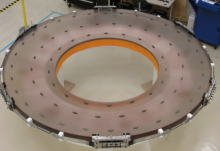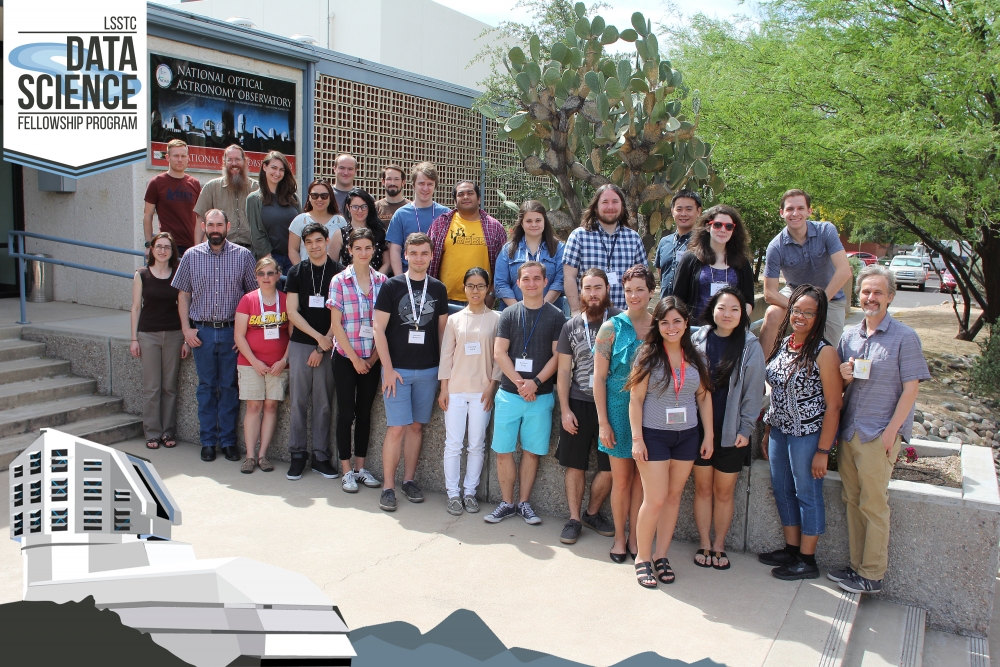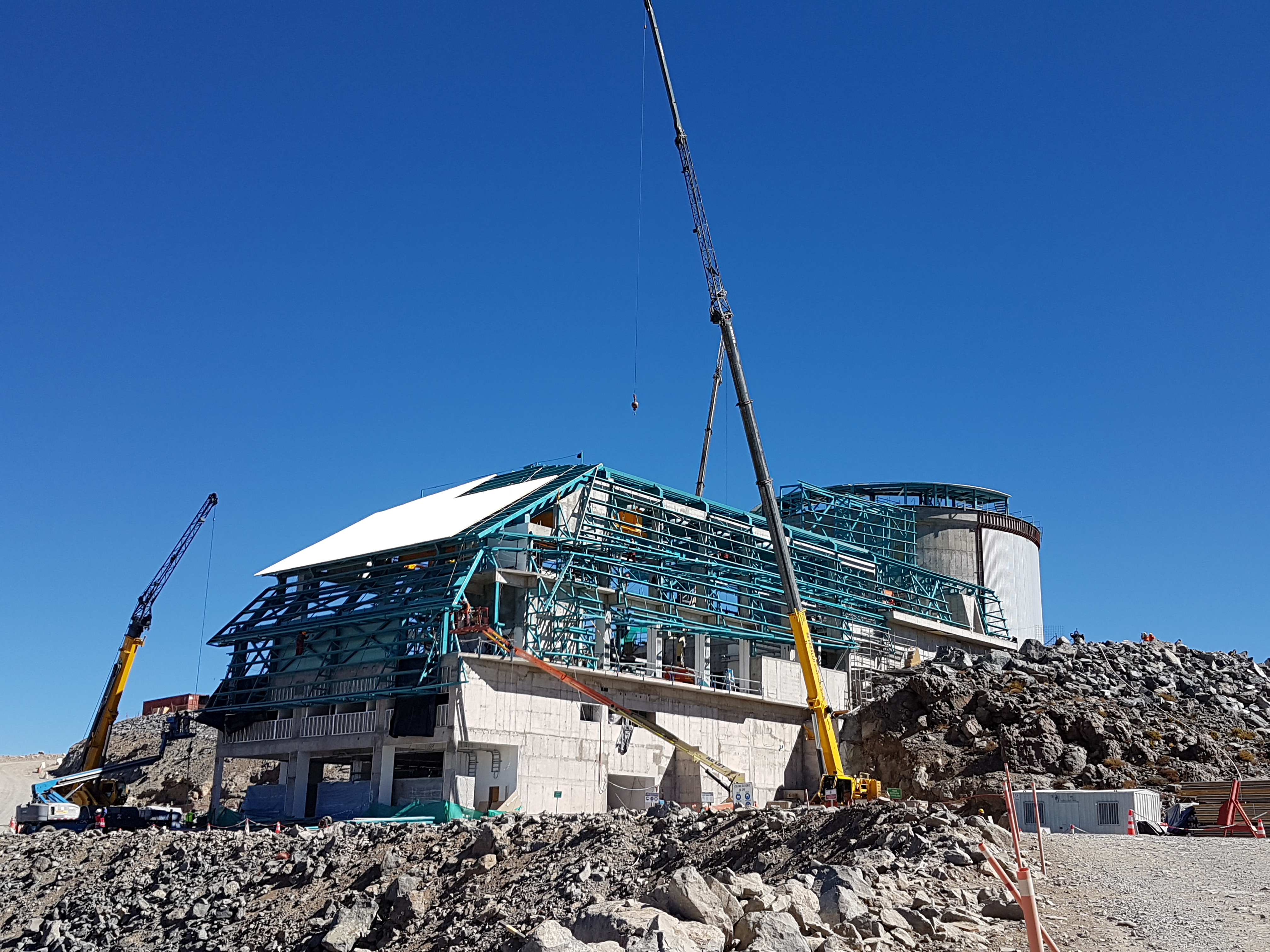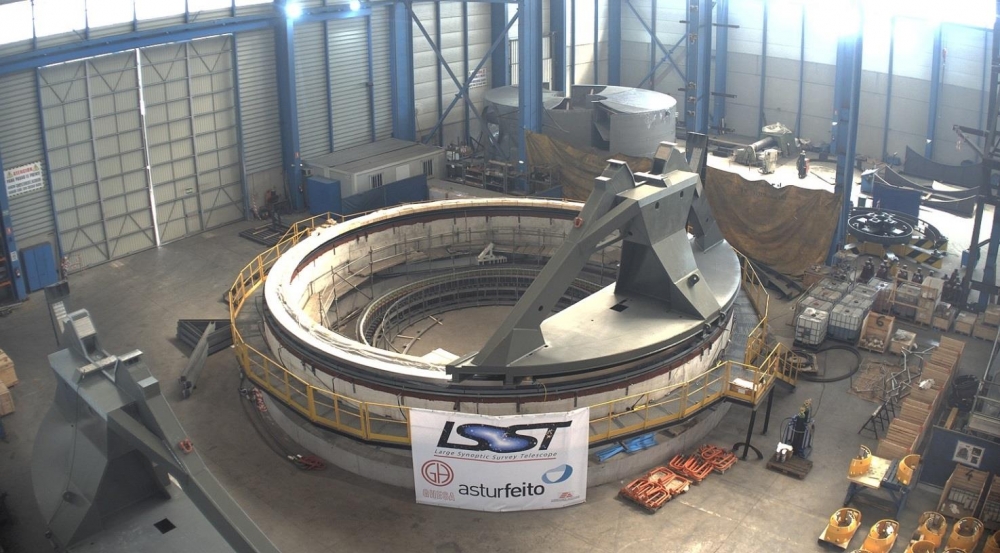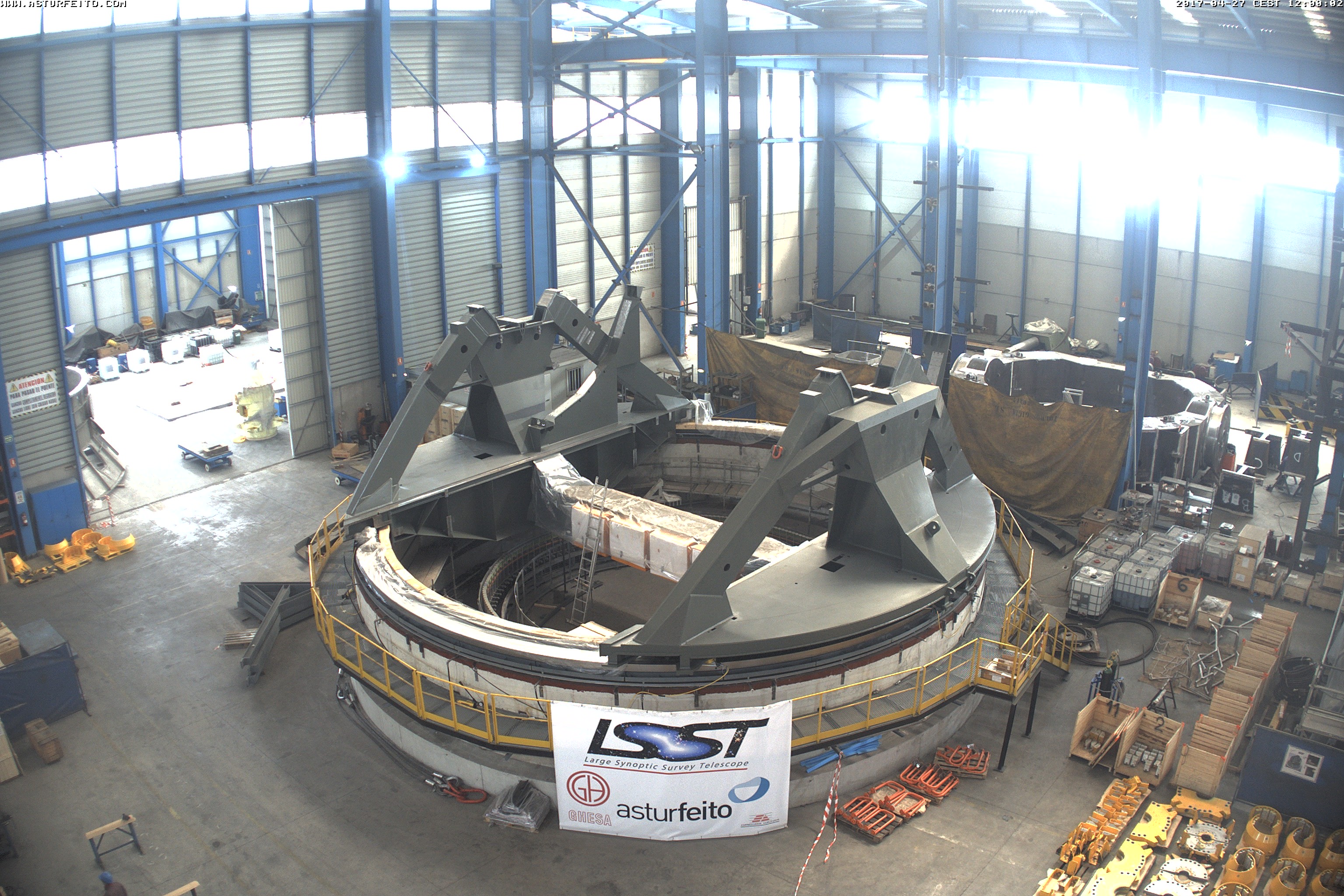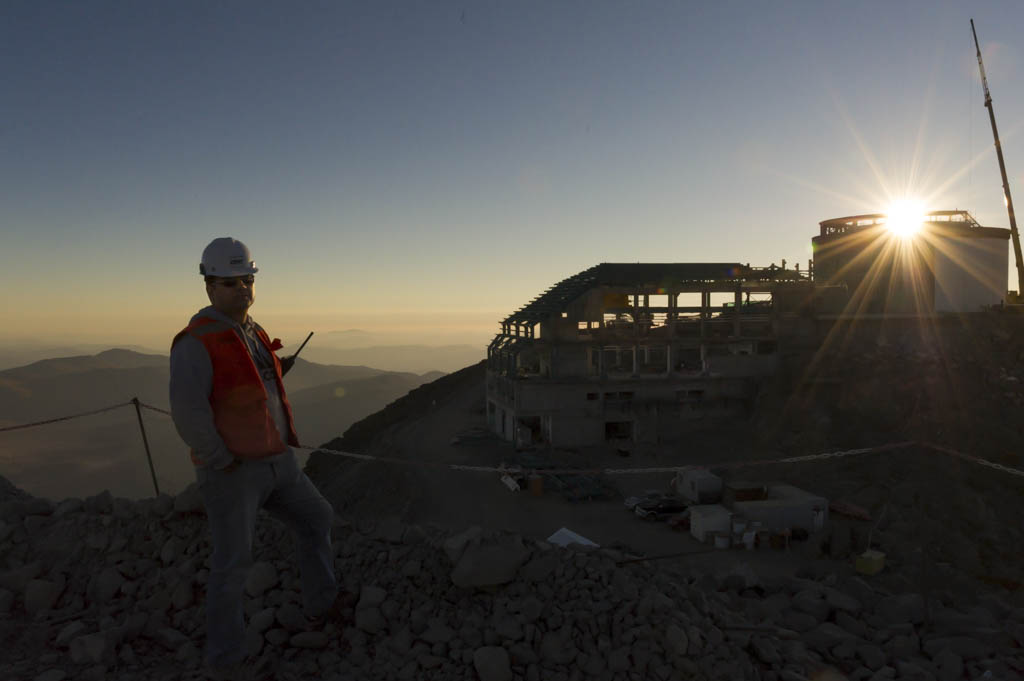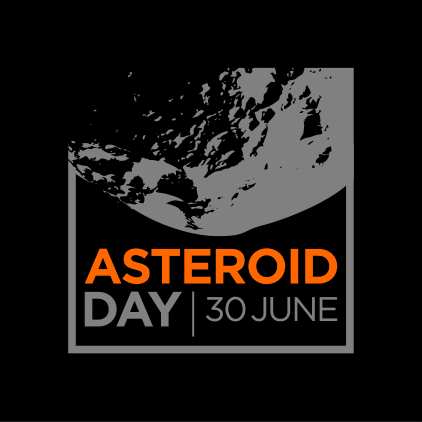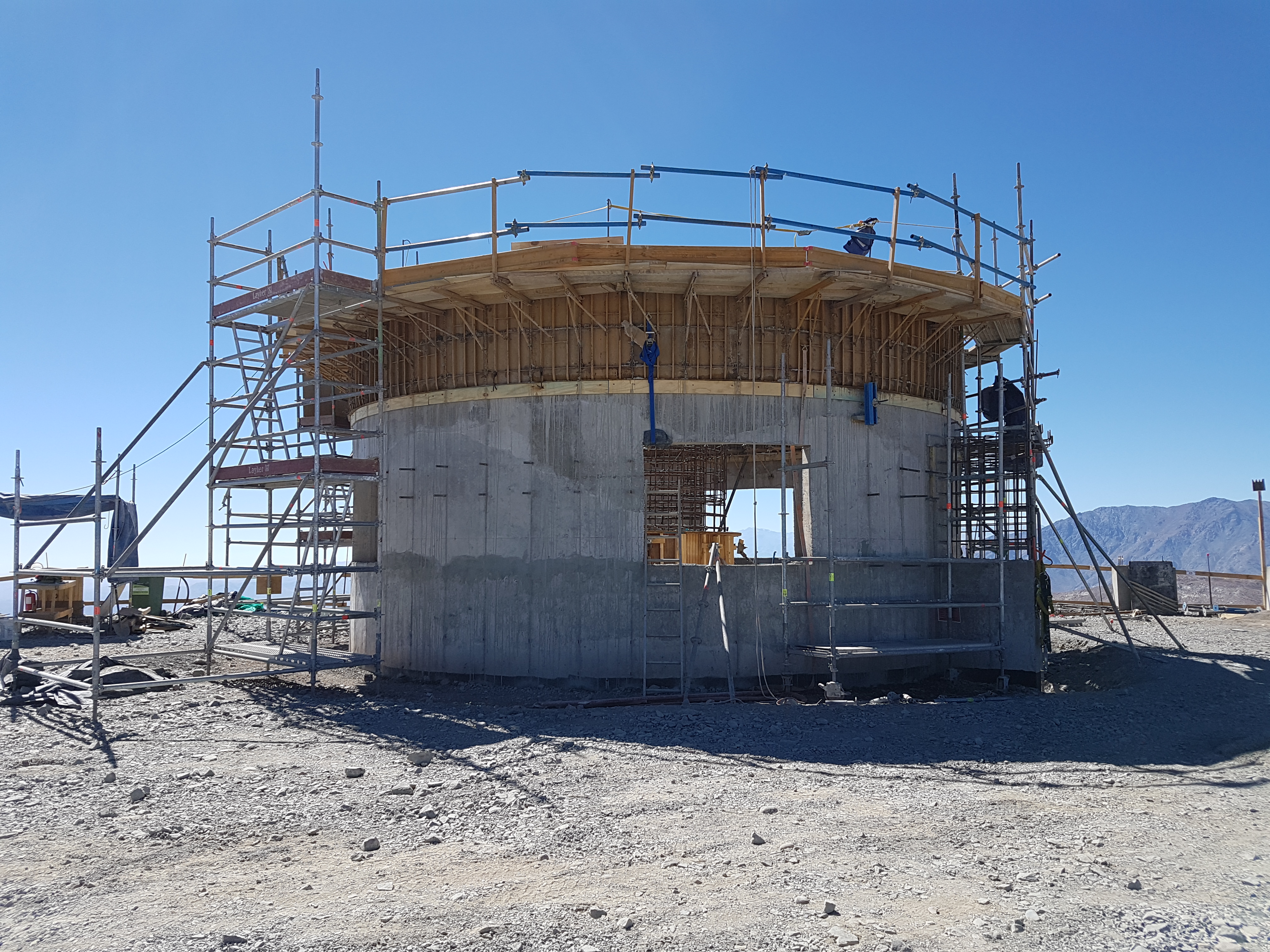Dear Reader, we anticipate settling into a bi-weekly distribution for the LSST Digest once we have a full-time Communications Manager. Thank you for your continued interest.
The LSST Project Office is currently supporting an on-site incurred cost audit from the NSF. This is the first time LSST and AURA have taken part in this type of audit. Going forward, we expect it will become routine. The audit will investigate LSST’s compliance with the financial requirements of our Cooperative Agreement as well as Office of Management and Budget’s Uniform Guidance.
A multimedia team visited Cerro Pachón in early April to gather high-quality images and video footage of LSST's construction progress. LSST staff assisted the team in obtaining material safely and without disrupting construction progress. Images and more information found here.
LSST's EPO staff has signed a contract to purchase Webdam, a system for Digital Asset Management. Webdam will provide a tool for organizing and storing LSST's photos and video footage, in a secure, centralized location. The system will increase efficiency for preserving digital assets to help prevent them from being lost over time.
Chairs of the LSST Science Collaborations joined the Project Science Team for their monthly joint telecon to discuss DM plans for crowded field processing. A presentation by Jim Bosch, Data Release Production Scientist from Princeton University, is available here.
Construction on the Base Facility on the La Serena Recinto is moving forward with contractor Rencoret. They have finished installation of their construction office facilities and have begun site preparation to support the initial work (renovation of the existing building). Those interested can follow progress at the Base Facility Construction website for plans, the on-site webcam, and frequent updates on activities impacting those accessing the Recinto.
Dome vendor EIE has begun mobilization on the Cerro Pachón summit, with containers arriving by truck, staging areas being cleared, and the establishment of new office space to support assembly tasks. Initial work will focus on alignment of the plates atop the lower enclosure to prepare for attachment of the azimuth ring and bogie wheels.
“Raising the roof” has officially begun, with the first piece of white steel roof paneling going up on the LSST facilities building. Check our Facebook page for updates.
Fabrication and integration of the Telescope Mount Assembly (TMA) continues in Spain. The large steel structural components that make up the azimuth assembly are painted and undergoing installation on the Spanish pier. Read more.
The LSST secondary mirror (M2) system has completed another big milestone, with successful demonstration of closed-loop mirror control. The Harris team accomplished this using the completed deliverable support hardware, LSST developed local control electronics and an aluminum surrogate mirror. Meanwhile, the mirror substrate is being prepared for its “first light optical test” in July at Harris in Rochester, NY, with the successful bonding of all actuator pads (see photo).
CORPORATION NEWS
The third session of the LSSTC Data Science Fellowship Program (DSFP) is underway this week in Tucson, AZ. This is the third meeting of the first cohort of fellows. The DSFP fellows are joined by four local University of Arizona auditing students who are spending the week studying databases and scalable programming.
PERSONNEL NEWS
New software positions in the Telescope & Site group have been added to the LSST Hiring Page, joining an existing listing for a Telescope Optical Engineer and many other excellent career opportunities. Please spread the word, and help us recruit the best and brightest to LSST!
Rodrigo Rojas joined the Telescope & Site subsystem as Polyfunctional Operator, based in La Serena. In this position, Rodrigo operates boom truck, fork cranes, man-lifting equipment and other types of heavy machinery, and drives high tonnage vehicles as well as smaller passenger and cargo vehicles according to requirements. Rodrigo will work as a rigger and mechanic, and will support other types of work assembly and general equipment maintenance.
Juan Fabregas was recently hired as the Electrical ITO (“Inspector Técnico de Obra”, Site Technical Inspector) in our Chile office. He will be working fulltime for LSST on general electrical inspection tasks to support the main building fabrication effort.
At NCSA, Jacob Rundall joined the LSST Data Management subsystem as IT Systems Engineer. Jacob will be helping to construct and operate compute systems supporting development and production services at NCSA.
UPCOMING MEETINGS with LSST INVOLVEMENT
(those with asterisk* are LSSTC funded):
2017
|
|
|
April 24-28
|
Data Science Fellowship Program – Session 3 * Tucson, AZ
|
|
May 1 – 3
|
NSF Large Facilities Workshop, Baton Rouge and Livingston, LA
|
|
May 1 – 5
|
AURA Board and Member Representatives Annual Meeting, Tucson, AZ
|
|
May 12 - 13
|
LSST Detection of Optical Counterparts of Gravitational Waves*, BNL. Contact Morgan May for additional information.
|
|
May 22 – 25
|
Infrastructure for Time Domain Science in the Era of LSST, Tucson, AZ
|
|
May 31 - June 2
|
Supernovae: The LSST Revolution Workshop *, Northwestern University, Evanston, IL
|
|
June 12 – 16
|
Getting Ready for Doing Science with LSST Data,* IN2P3, Lyon, France
|
|
June 19 – 21
|
AURA Workforce and Diversity Committee (WDC), Maui, HI
|
|
July 10 - 14
|
DESC Meeting, Dark Energy School, and Hack Day*, jointly hosted by Stony Brook University & BNL
|
|
July 25 – 27
|
NSF/DOE Joint Status Review of Data Management, NCSA, IL
|
|
August 14 – 18
|
LSST 2017 Project & Community Workshop, Tucson, AZ
|
|
September 6 – 8
|
NSF/DOE Joint Status Review, Tucson, AZ
|
|
September 14 – 15
|
AURA Management Council for LSST (AMCL) Meeting, Tucson, AZ
|
|
October 26 – 28
|
Society of Women Engineers WE17 Conference, Austin, TX,
|
Get your LSST gear at our storefront: https://business.landsend.com/store/lsst/
Querido lector, esperamos distribuir las Noticias de LSST cada dos semanas una vez que tengamos un Gerente de Comunicaciones de tiempo completo. Gracias por su constante interés.
Noticias del Proyecto
La Oficina del Proyecto LSST está apoyando una auditoria de costos de la NSF en sitio actualmente. Esta es la primera vez que LSST y AURA han sido parte de este tipo de auditoría. De ahora en adelante, esperamos que se convierta en rutina. La auditoría investigará el cumplimiento de LSST de los requisitos financieros de nuestro Acuerdo de Cooperación así como las Directrices Uniformes de la Oficina de Gestión y Presupuesto Office of Management and Budget’s.
Un equipo multimedia visitó Cerro Pachón a comienzos de Abril para recoger imágenes de alta calidad y vídeo del progreso de la construcción de LSST. Personal de LSST ayudó al equipo en la obtención de material en forma segura y sin interrumpir el progreso de la construcción. Imágenes y más información aquí here.
Personal de EPO LSST ha firmado un contrato para la compra de Webdam, un sistema de Gestión de Activos Digitales. Webdam proporcionará una herramienta para organizar y almacenar fotos y videos de LSST en una ubicación segura y centralizada. El sistema aumentará la eficiencia para preservar los activos digitales para ayudar a impedir que se pierden en el tiempo.
Miembros de la presidencia de Colaboraciones Científicas de LSST se juntaron con el Equipo Científico del Proyecto en su teleconferencia conjunta mensual para discutir los planes de DM para el procesamiento de campos abarrotados. Una presentación por Jim Bosch, Científico de Liberación de Datos de Producción de la Universidad de Princeton, está disponible aquí here.
La construcción de las Instalación Base en el Recinto de La Serena, está avanzando con el contratista Rencoret. Se ha terminado la instalación de faenas y ha comenzado la preparación del sitio para apoyar el trabajo inicial (renovación del edificio existente). Aquellos interesados pueden realizar el seguimiento de los avances de construcción en el sitio web website para visualizar planes, la webcam en sitio, y las frecuentes actualizaciones sobre las actividades que afectan a las personas que acceden al Recinto.
El proveedor del domo EIE, ha comenzado movilizaciones en el sitio de Cerro Pachón, con contenedores que llegan en camión, zonas de montaje siendo despejadas, y el establecimiento de espacios de oficina para apoyar las tareas de ensamblaje. El trabajo inicial se centrará en la alineación de las placas en la cima del lower enclosure para preparar el montaje del anillo acimut y ruedas bogie.
"Levantando el techo" ha comenzado oficialmente, con la primera pieza de paneles de techo de acero blanco del edificio de servicios de LSST siendo instalada. Visita nuestra página de Facebook Facebook page para ver actualizaciones.
Fabricación e integración del Conjunto de Montaje del Telescopio (TMA) continúa en España. Los grandes componentes estructurales de acero que componen el montaje acimut están pintadas y siendo instalados en el pier en España. Leer más.
El sistema del espejo secundario (M2) de LSST ha completado otro gran hito, con una demostración exitosa de control del espejo de bucle cerrado. El equipo de Harris logro esto usando el hardware de soporte final completo, LSST desarrollo electrónica de control local y un espejo suplente de aluminio. Mientras tanto, el sustrato del espejo está siendo preparado para su "primera prueba óptica de luz" en Julio en Harris, Rochester, NY, con la adhesión exitosa pads del actuador (ver foto).
Noticias de la Corporación
La tercera sesión del Programa de Becas de Datos Científicos (DSFP) de LSSTC está en marcha esta semana en Tucson, AZ. Esta es la tercera reunión de la primera cohorte de becarios. Se han unido cuatro estudiantes locales de auditoría de la Universidad de Arizona a los becarios DSFP quienes están pasando la semana estudiando las bases de datos y programación escalable.
Noticias de Personal
Nuevos puestos de software en el grupo de Telescopio y Sitio se han agregado a la página de reclutamiento de LSST LSST Hiring Page, integrándose al anuncio existente para un Ingeniero Optico de Telescopio y muchas otras excelentes oportunidades de carrera. Por favor, difundir la palabra, y ayúdenos a reclutar a los mejores y más brillantes para LSST!
Rodrigo Rojas se unió al subsistema de Telescopio & Sito como Operador Poli funcional, en La Serena. En esta puesto, Rodrigo opera camiones pluma, grúas horquilla, equipos de izaje y otros tipos de maquinaria pesada, y maneja vehículos de alto tonelaje, así como pequeños vehículos de pasajeros y de carga según las necesidades. Rodrigo trabajará como rigger y mecánico, y prestará apoyo a otros tipos de trabajo ensamblaje y mantenimiento general de equipos.
Juan Fábregas recientemente fue contratado como el ITO eléctrico ("Inspector Técnico de Obra") en nuestra oficina de Chile. Él estará trabajando a tiempo completo para LSST en tareas de inspección eléctrica general para apoyar el esfuerzo de fabricación del edificio principal.
En NCSA, Jacob Rundall se unió al subsistema de Gestión de Datos de LSST como Ingeniero de Sistemas. Jacob estará ayudando a construir y operar sistemas informáticos para apoyar el desarrollo y los servicios de producción en NCSA.
Próximas reuniones con participación de LSST
(aquellas con un asterisco* son financiados por LSSTC):
2017
|
|
|
Abril 24-28
|
Data Science Fellowship Program – Session 3 * Tucson, AZ
|
|
Mayo 1-3
|
Taller de Gran Instalaciones de NSF, Baton Rouge y Livingston, LA
|
|
Mayo 1-5
|
Reunión Anual de la Junta de AURA y Miembros Representantes, Tucson, AZ
|
|
Mayo 12-13
|
LSST Detection of Optical Counterparts of Gravitational Waves*, BNL. Contactar a Morgan May para obterner informacion adicional.
|
|
Mayo 22-25
|
Infrastructure for Time Domain Science in the Era of LSST, Tucson, AZ
|
|
Mayo 31-Junio 2
|
Supernovae Workshop *, Northwestern University, IL
|
|
Junio 12-16
|
Getting Ready for Doing Science with LSST Data, Lyon, France
|
|
Junio 19-21
|
Fuerza Laboral de AURA & Comité de Diversidad (WDC), Maui, HI
|
|
Julio 10-14
|
DESC Meeting, Dark Energy School, and Hack Day*, Brookhaven National Lab
|
|
Julio 25-27
|
Revisión de Estado Conjunta para Gestión de Datos NSF/DOE, NCSA, IL
|
|
Agosto 14-18
|
Taller de Proyecto & Comunidad LSST 2017, Tucson, AZ
|
|
Septiembre 6-8
|
Revisión de Estado Conjunta NSF/DOE, Tucson, AZ
|
|
Septiembre 14-15
|
Reunión Consejo de Gestión de AURA para LSST (AMCL), Tucson, AZ
|
|
Octubre 26-28
|
Conferencia Sociedad de Mujeres Ingenieros WE17, Austin, TX
|
Obtenga su equipo LSST en la tienda: https://business.landsend.com/store/lsst/


